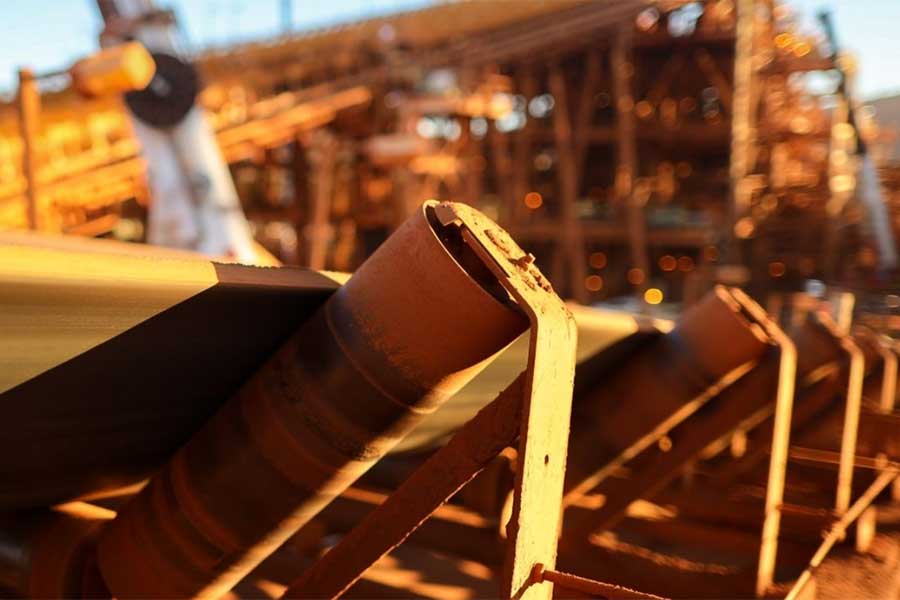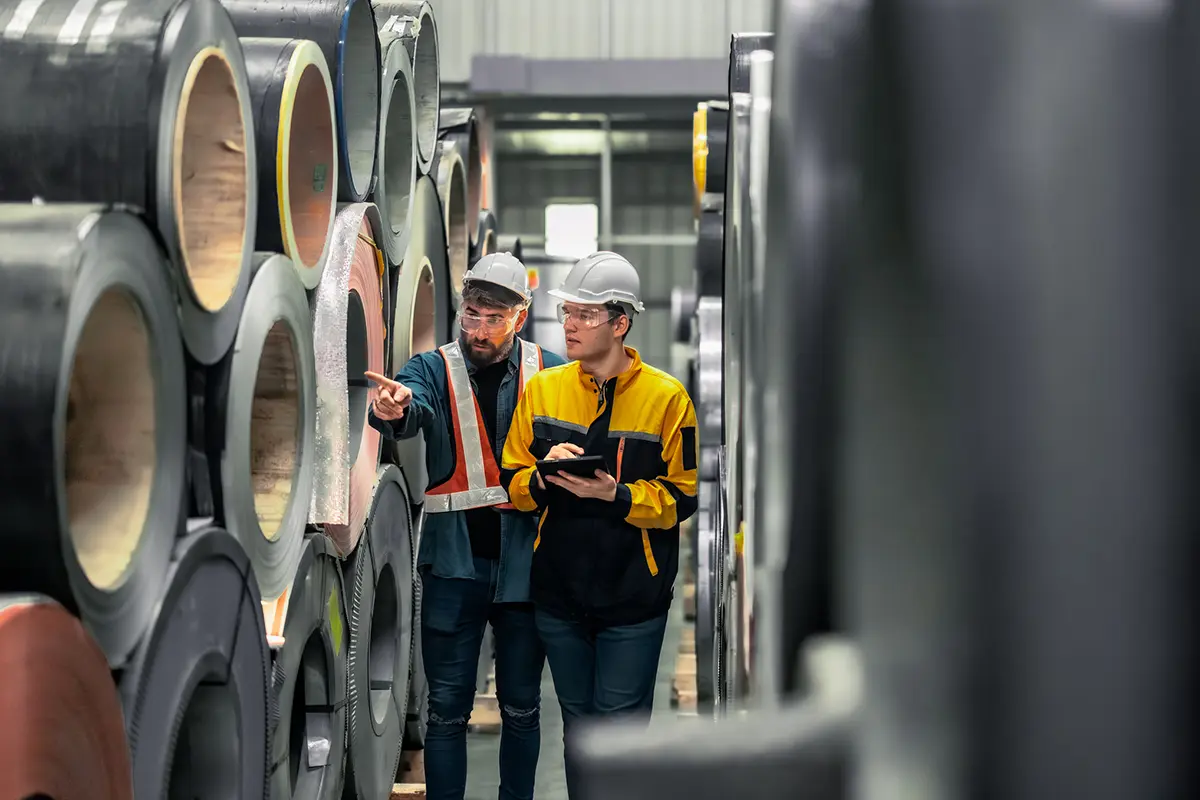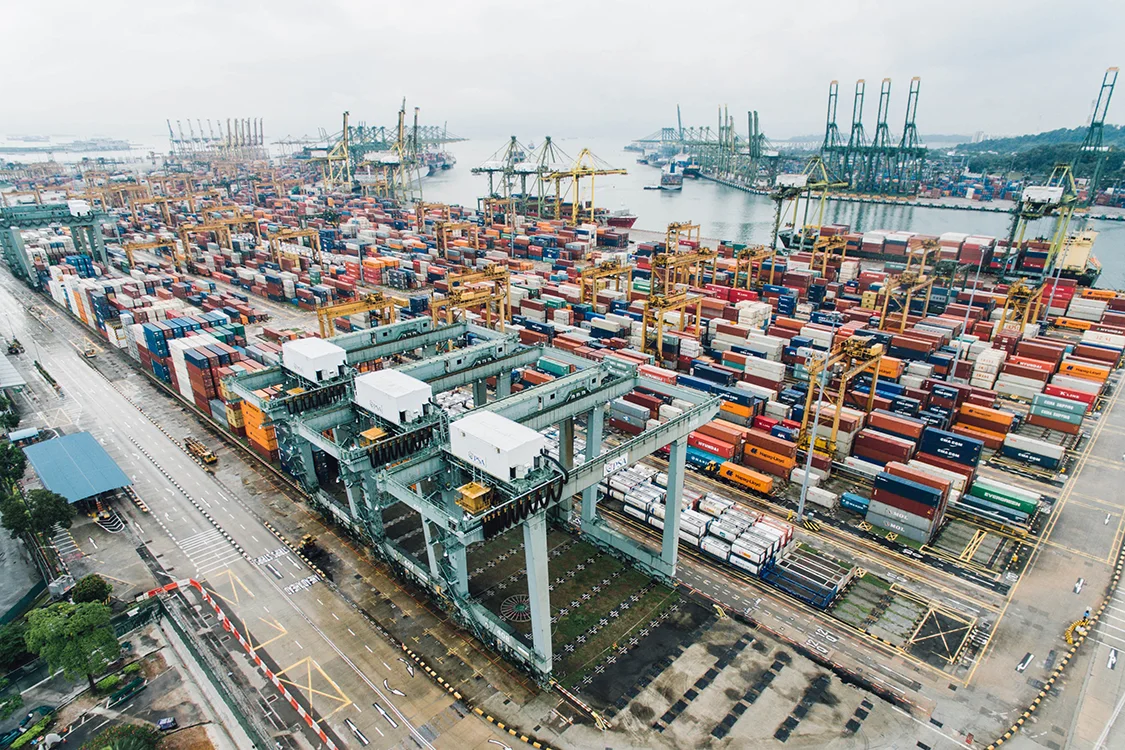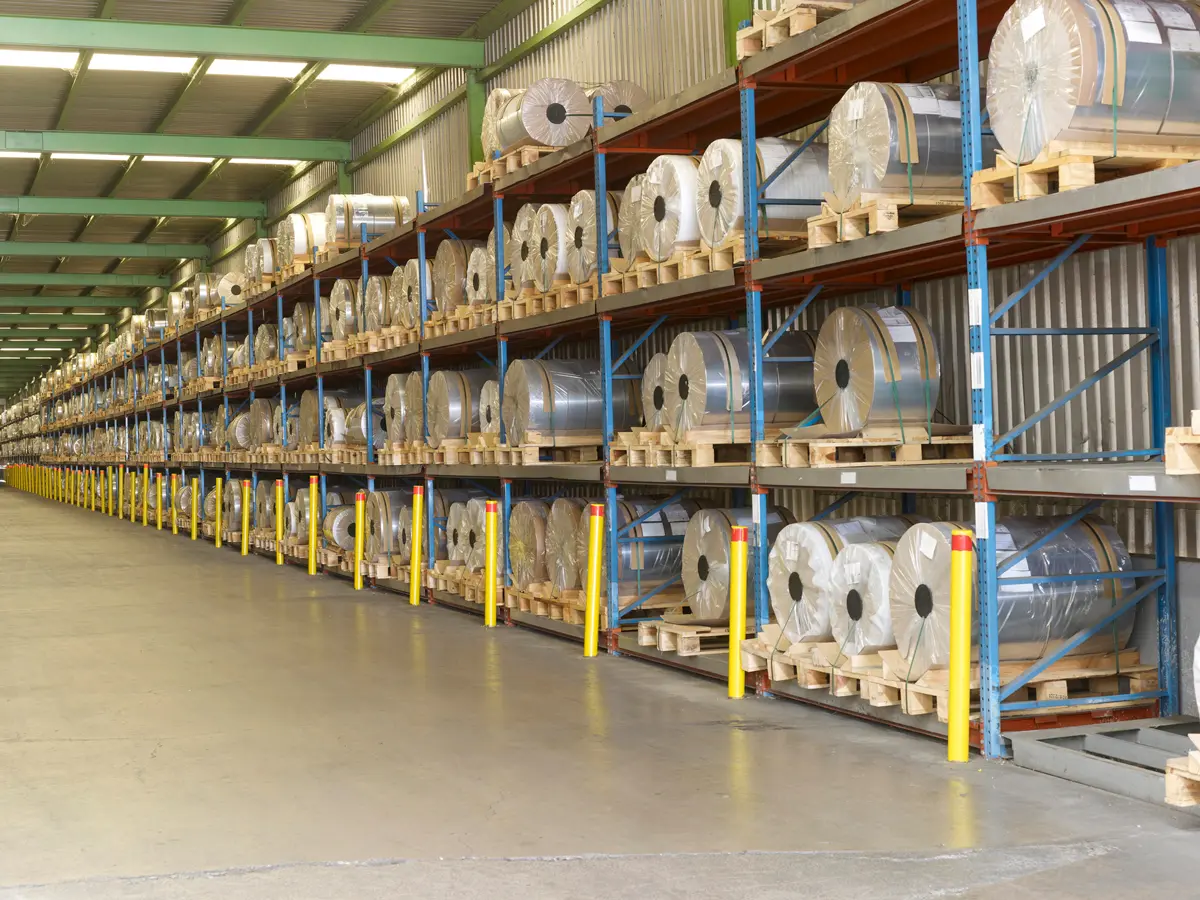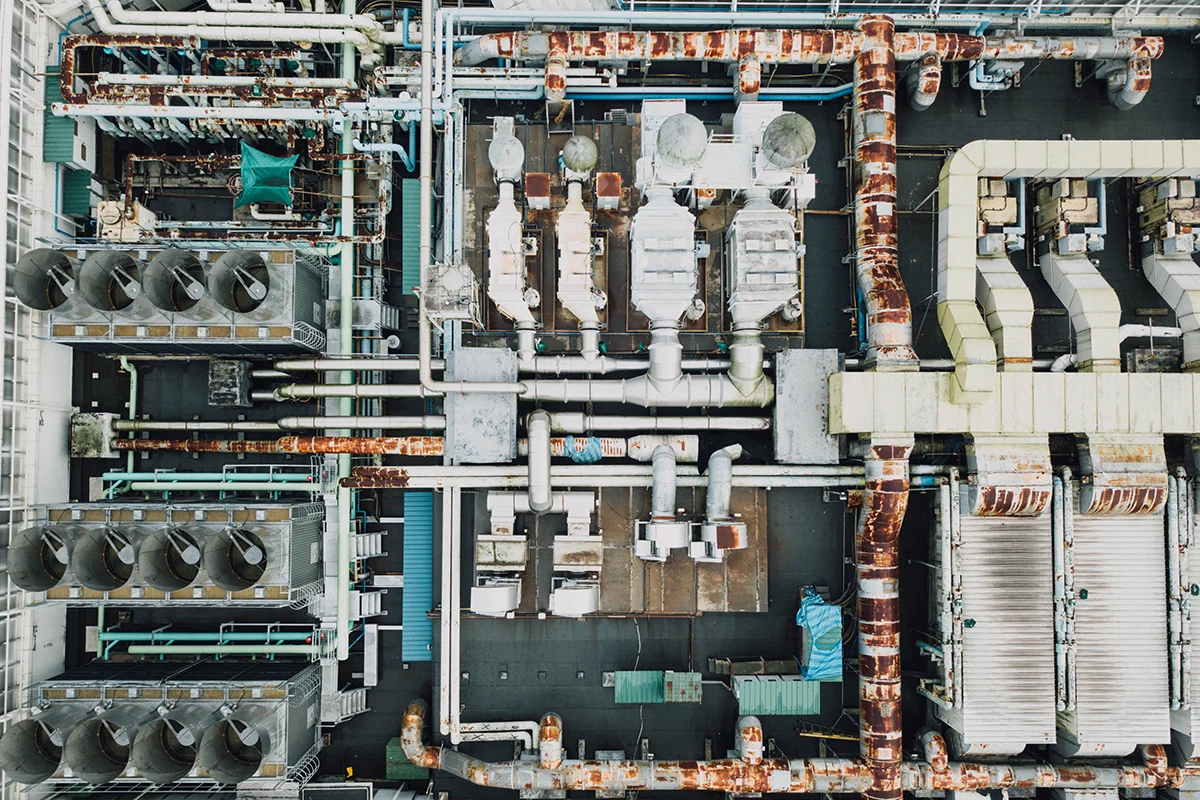January 2023 update: we’ve recently published a more comprehensive guide about mining digital transformation which you can review in addition to this guide below.
Despite the mining sector being behind other sectors when it comes to digital transformation, the tide is starting to turn. Under pressure to improve profits and output while simultaneously reducing emissions and meeting environmental, social and governance requirements, mining leaders are realising the enormous benefits that digitisation can bring.
In a recent survey, 99 per cent of mining company decision makers said technology and innovation were ‘critical’ to their organisation’s survival [ii]. The senior technology executive of a major mining firm in a recent article suggested that their digital transformation initiative was set to unlock ‘hundreds of millions of dollars of untapped value a year’ [iv].
Yet despite the best intentions – and some impressive progress – many challenges remain. For many organisations, opportunities for insight and innovation are being missed, especially when it comes to the minerals processing segment of the mining value chain. So why is this happening? And what can be done?
In this first article of a two-part series recently published by AusIMM, our Managing Director John Vagenas discusses some of the challenges and outlines the fundamentals of digital transformation in helping mining organisations achieve their goals.
Digital transformation: a few common pitfalls
Overly broad, ‘catch all’ solutions
For many organisations, the immediate and obvious solution to rapid digital transformation has been to invest in large-scale, multi-sector, overarching solutions that provide efficiencies and insights across the full mining value chain. These solutions help with everything from extraction and exploration through to occupational health and safety. However, while these ‘one-size-fits-all’ solutions do deliver some benefits at a high level, they’re not designed to handle the complexity of the various types of processes specific to minerals processing plants. As a result, this processing segment of the mining value chain is often overlooked, with huge opportunities being missed.
Failure to ‘close the loop’ between strategy and execution
Most metals and mining companies have ambitious digital strategies in place; however, the gap between strategy and execution is often significant – especially relative to other industries [i].
Lack of customisation
According to a recent survey, only 25 per cent of metals and mining companies use customised digital solutions [i]; instead, they tend to opt for generalised, off-the-shelf solutions.
‘Big bang’ implementation
When solutions are implemented all at once rather than with a phased approach, the process can often be quite disruptive and, potentially, debilitating for the organisation. While rapid implementations can be successful, this requires engaged leadership and subject matter expertise.
‘Set and forget’ approach
While digital solutions are designed to streamline workloads and automate processes, they also need to be actively utilised in order to deliver results. A robust digital solution can’t simply be implemented and then left to produce insights in the background. Similarly, organisations need to ensure they have skilled in-house professionals who can effectively manage a digital solution on an ongoing basis, and to drive required improvements and innovations.
Overlooking the minerals processing segment of the mining value chain
Despite many organisations progressing with their overall digital transformation, a key piece of the puzzle is often overlooked and undervalued: minerals processing. As Figure 1 indicates, minerals processing is a specific part of the overall mining value chain.

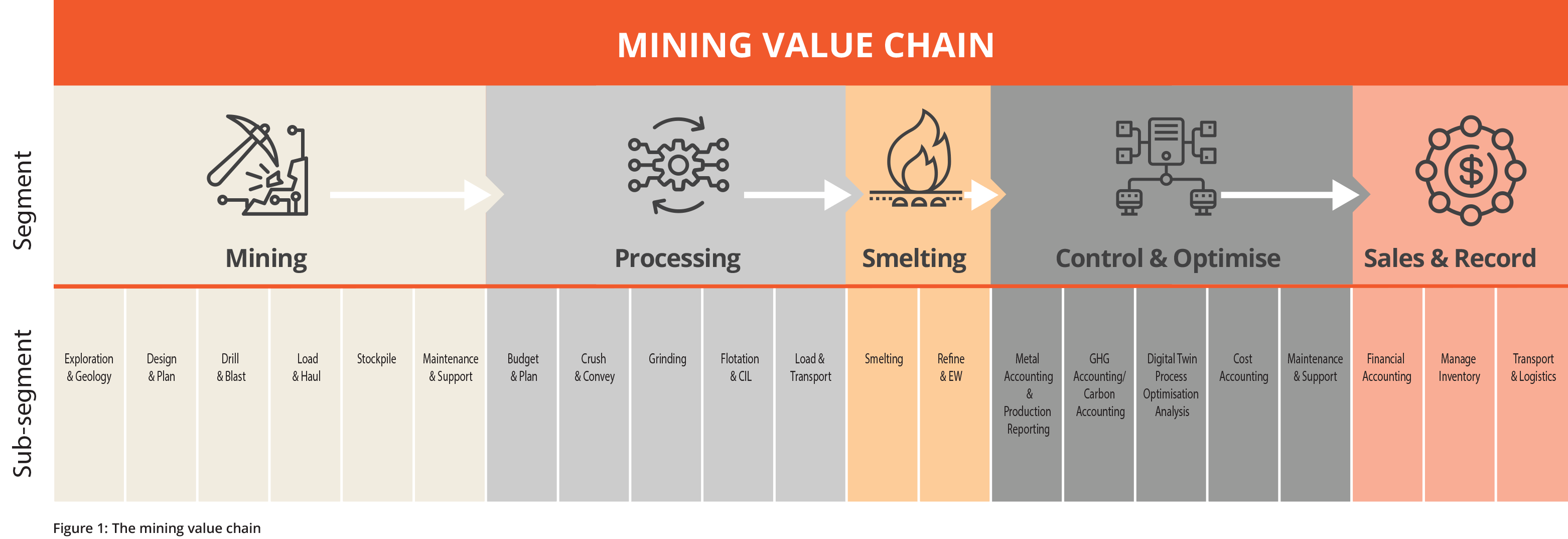
Optimisation of minerals processing is a specialised area and requires knowledge of many disciplines, including software engineering, IT architecture and data flows, chemical and process engineering, process design and simulation and communication protocols. This segment of the mining value chain requires a unique balance of understanding metallurgy and its complexities, as well as how to integrate process chemistry with modern digital technology. As such, it is often overlooked or oversimplified with overly manual tools – meaning enormous opportunities for improvement and insight are missed.
So what does effective digital transformation for minerals processing look like?
To understand what it takes to digitally transform the minerals processing segment of a mining organisation, it can be helpful to reference the automation pyramid – a model developed by the International Society of Automation.
Essentially, this model provides standards as to how different enterprise and control systems should work together to reduce errors, risk and costs. It is a well-established model that is widely adopted in many sectors, especially in industrial manufacturing.
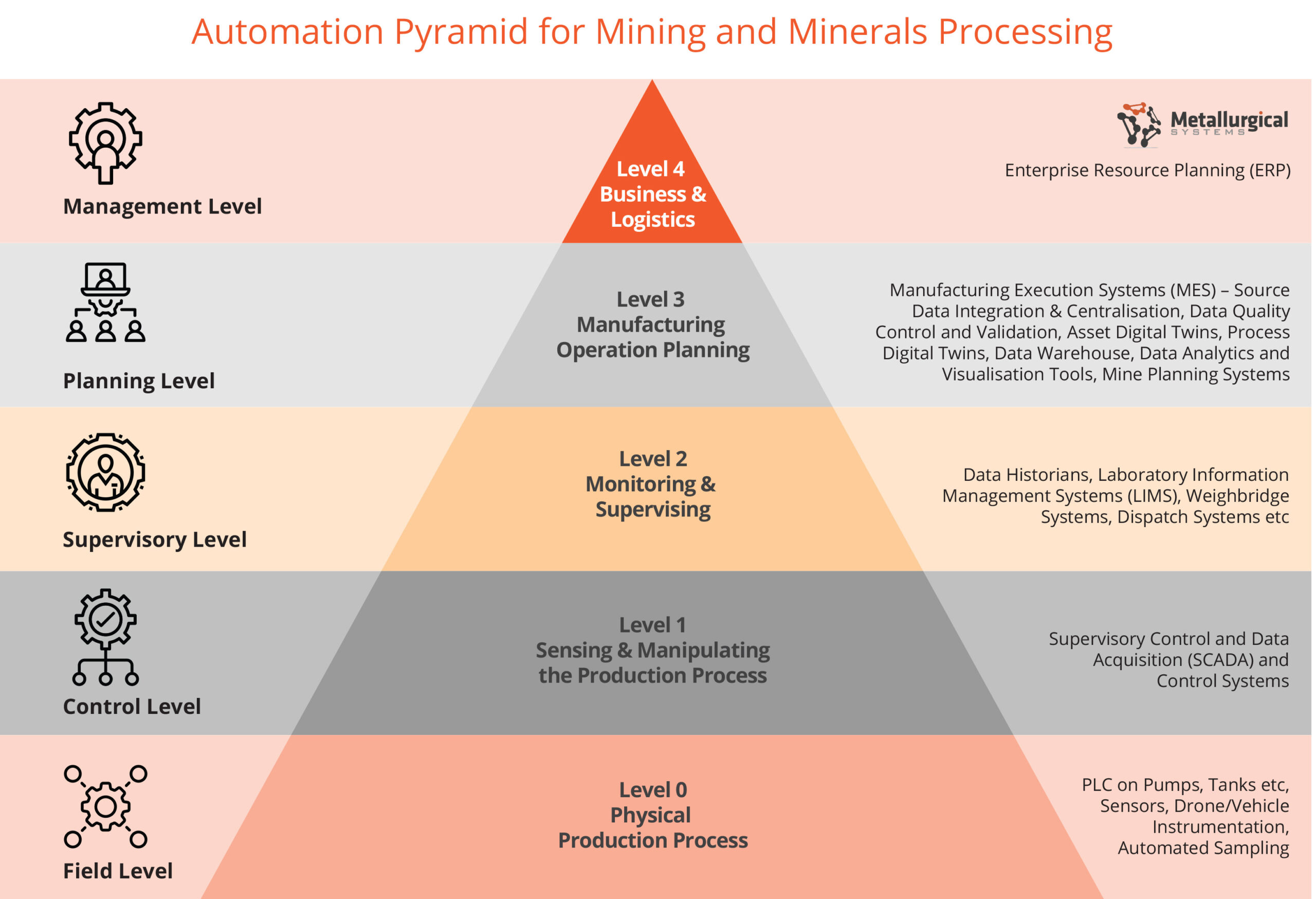
To realise the most value from a digital transformation implementation, all these levels of automation need the right digital solutions in place – and these solutions need to work together in a seamless, integrated manner.
Here’s a quick overview of what these levels mean:
Level 0 – Field
This is the essential ‘base’ level of any plant’s optimisation. It’s where data is captured through IoT devices – including flow metres, density gauges, weightometers and other instrumentation that actively monitors production variables.
Level 1 – Control
Devices in this level receive data from devices at the field level and use this data to control the production process. In the minerals processing segment, this is where you would find supervisory control and data acquisition (SCADA) and control systems. In the mining segment, there are several solution suites that interface with onboard vehicle systems and make this data available to higher-level dispatch and mine control software.
Level 2 – Supervisory
For the processing segment, this level is where you would find production data historians and laboratory information management systems (LIMS). For the mining segment, mine control, operations, short-term planning or haulage solutions may also be found here.
Level 3 – Planning
This is where you have systems and tools that monitor the entire production process, from raw material to finished goods. For the processing segment, this layer is where you will typically find a Manufacturing Execution System (MES). A MES is responsible for gathering, integrating, validating and centralising source data, as well as making it available to employees through analytics and visualisation tools. A high-quality MES will source data from right across the plant and from all levels of this automation pyramid. In the mining segment, medium- to long-term mine planning solutions would be found at this level, as well as common solutions such as health and safety.
Level 4 – Business and Logistics
This is the ‘C-suite’ layer of the pyramid: the enterprise layer that gives the organisation’s decision-makers information extracted from all levels of the automation pyramid and relating to all aspects of the plant’s or mine’s operation. This is where an Enterprise Resource Planning (ERP) Solution would be found. These usually receive information from Level 3 and map it to financial aspects of the operation. Typically sales, marketing and perhaps supply chain solutions are introduced here, which may also have representation at lower levels of the pyramid, depending on complexity.
Where does the ‘digital twin’ fit in?
Over the last 10 years, innovations in digitisation have led to some incredibly advanced solutions, or digital-twin-enabled MES, being developed for the planning level of the automation pyramid.
There are many different types of digital twins used across several different industries. Each twin is built differently and has unique and specific applications. For mining, there are two distinct types of digital twin solutions that are used: asset digital twins and process digital twins.
Asset digital twins are used in the mining segment of the mining value chain. This is essentially a digital replica of the physical components of a mine, developed using CAD modelling. For example, this could include 3D models for mine planning such as pit designs, haul routes and mine layouts. This type of digital solution helps people visualise a facility when working at a remote location.
Process digital twins are far more sophisticated digital twins and are used at the processing segment of the mining value chain. A process digital twin is a digital replica of the actual processing of the ore body for a minerals processing plant – from raw material to finished product. This type of digital twin uses dynamic simulation and considers a range of physical properties such as temperature and pressure. The simulated model also considers the specific chemical equations and processes that occur at each step of the refining process.
Process digital twins form part of the core of a digital-twin-enabled MES at the planning level of the automation pyramid. The dynamic simulated model draws all the data from the automation layers beneath it. The outputs calculated by the dynamic model are connected directly to all the source data. It is this functionality that gives the model the ability to use machine learning to perform intelligent calculations for greater insight. The source data and calculated data from all of these layers is validated, organised structured and pre-aggregated in the MES.
Some organisations may use a ‘bolt-on’ application or module with a traditional MES where data structures are not connected, and calculations are therefore limited – with no dynamic simulation of the process and no machine learning functionality.
How does it all fit together?
If we integrate the automation pyramid (Figure 2) with the mining value chain (Figure 1), we end up with a map that identifies the various solutions that are currently available in the market across each segment of the mining value chain and within each layer of the automation pyramid.

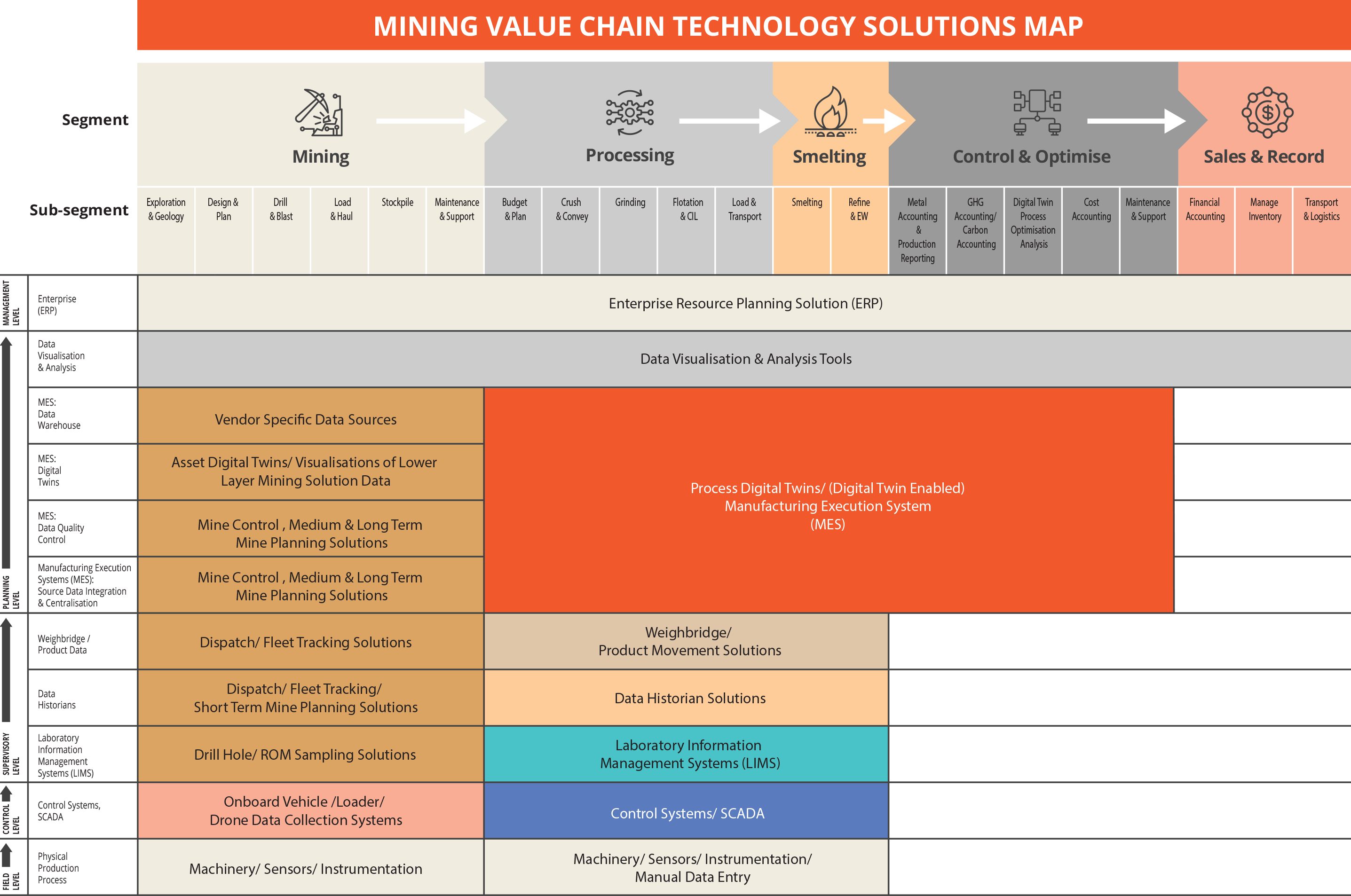
The ‘mining’ segment of the mining value chain is well established, and there are several solutions available in the market, each addressing one or more sub-segments of the value chain, or the automation layers.
However, once we move into the ‘processing’ and ‘smelting’ segments of the mining value chain, there are some glaring gaps.
This segment does have field, control and supervisory solutions that are well established, developed and readily adopted by the industry.
However, the ‘processing’, ‘smelting’ and ‘control and optimise’ mining value chain segments often do not have any planning solutions in place – specifically, they typically lack a digital-twin-enabled MES. Instead, this step is often poorly substituted with multipurpose software such as Microsoft Excel, which is unable to perform detailed and complex mass and energy balances it is tasked to do, with limited data storage, minimal audit and transparency and manual and error-prone reporting. These spreadsheets are then provided to management to feed into the management level, or ERP systems, for decision making and external reporting.
Without a digital-twin-enabled MES, only partial digital transformation can be achieved. This also means the other sub-segments further down the mining value chain – metallurgical accounting, production reporting, process optimisation and inventory tracking – cannot be calculated accurately. It also means financial accounting, managing inventory and ESG reporting become impossible to report quickly, accurately and reliably.
For a complete transition to digital transformation across the entire mining value chain, it’s vital that processing plants implement digital solutions for all layers of the automation pyramid. This enables all segments to be calculated accurately and effectively.
In part 2 of this article series, we will discuss the process digital twin in greater detail, provide an overview of its outputs and highlight its core components.
Read part two of the article series here.
Read more about digital transformation in minerals processing and Metallurgical Systems’ digital-twin-enabled MES technology here.
Take a look at this article written by Metallurgical Systems, and published on the AusIMM Bulletin, about the Digital transformation for minerals processing: the fundamentals (Part 1).
References
[i] Ganeriwalla A, Harnathka S, Costa A, Volkov M, and Voigt N, 2021. ‘BCG 2021. Adopting a digital strategy in the metals and mining industry’, Boston Consulting Group [online]. Available from:. https://www.bcg.com/en-au/publications/2021/adopting-a-digital-strategy-in-the-metals-and-mining-industry
[ii] Gleeson D, 2021. ‘Axora survey reveals mining sector moves towards digital transformation’ [online]. https://im-mining.com/2021/10/05/axora-survey-reveals-mining-sector-moves-towards-digital-transformation/
[iii] International Society of Automation. ‘ISA95, Enterprise-Control System Integration’ [online]. Available from: https://www.isa.org/standards-and-publications/isa-standards/isa-standards-committees/isa95
[iv] Smith P, 2022.AFR 22 Mar 2022. ‘Newcrest mines data in the cloud for a $100m virtual goldmine’, Australian Financial Review [online]. Available from: https://www.afr.com/technology/newcrest-mines-data-in-the-cloud-for-a-100m-virtual-goldmine-20220302-p5a15w
About the authors
This article has been collaboratively authored by the team at Metallurgical Systems, and fact-checked and authorised by Managing Director and industry specialist John Vagenas.

